|
Path, links, comments
The short tour is a way to get an introductory “feel”
for the site’s theme, scope and content
From the top of the tour page:
Below are a few foundational topics that aren’t immediately obvious:
Short tour: News ::: Urban ::: Thought collector ::: WESR ::: Attention directing & flow ::: Time books ::: Just reading is not enough :::
Secret office ::: Knowledge — THE resource ::: TAAB ::: GBTN ::: Jump back
Economic development

The main page is primarily about creating organization futures in a changing world
The page’s purpose is to provide a big picture, thinking landscape for
working through time
Navigating a changing world —
a world in profound transition
Examples: News ::: Road ahead: 1, 2, 3, 4, 5, 6 …

We can only work on and with the things on our radar

The prelude
A world moving toward unimagined futures
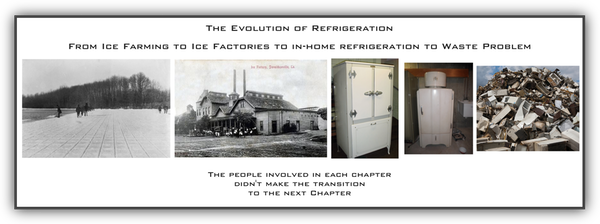
Mission ::: Continuity and Change

October 16th, 2003 — “Hell Froze Over.” Apple launched – iTunes for Windows.
That opened up the iPod to the 97% of people who had PCs.
Their first iPods turned into their first iPhones
… switched to a Macintosh all together
… along the way Apple’s market cap climbed to
the most valuable company in the world …
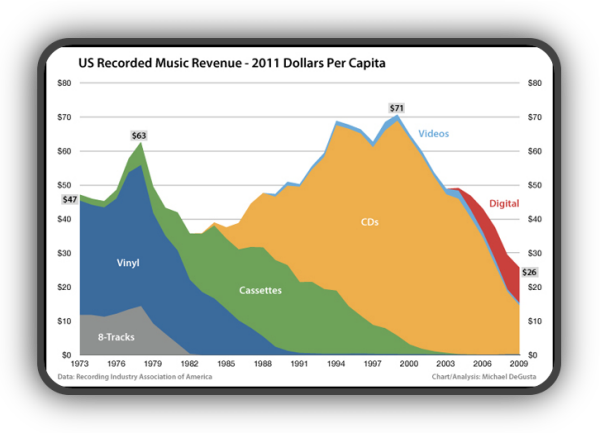
Film to Point-and-shoot to Smartphones
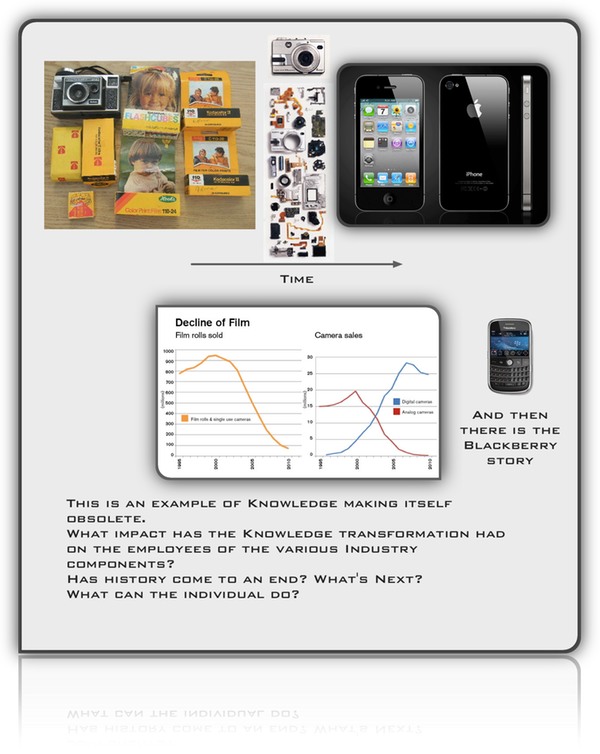
“Twelve cell phones that changed the world”

Europe: 1000 years in 10 minutes and
World History (3000 BC - 2013 AD)
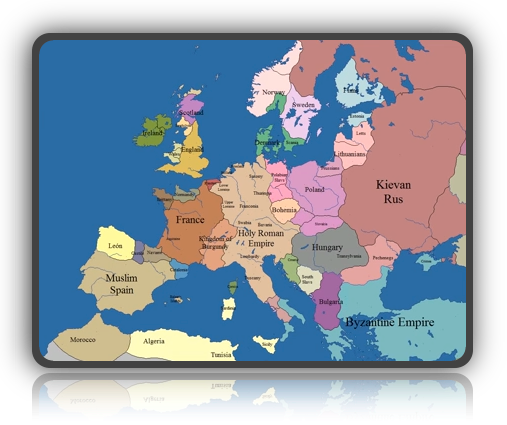
Strategy — The New Certainties #5
A view of economic content and structure
The patterns evident in the images above
exist in almost every area of the economy and society
“The world” is moving away from yesterdayS (1950, 1970, 1990 …)
The transformation
If you investigate the life story of any prominent organization
you’ll likely see multiple chapters in their story.
In some cases there are multiple stories with multiple chapters.
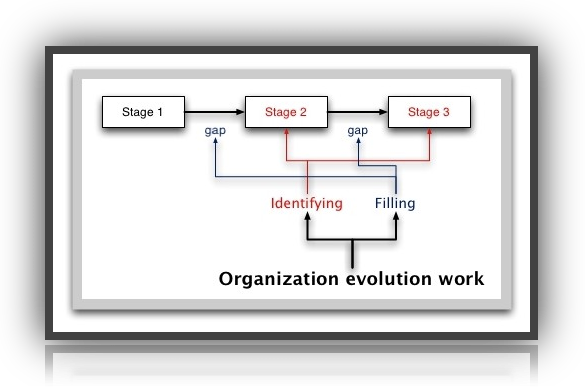
In some cases they started the next chapter early enough
and in others they waited for a near deadly crisis — they
were busy working on other things.
Deadly sins
Feeding problems and starving opportunities :::
Slaughtering tomorrow’s opportunity
at the altar of yesterday
Apple ::: Sears ::: AT&T ::: IBM ::: GM ::: Exxon ::: HP
JC Penny ::: Sony ::: Xerox ::: Nokia ::: Kodak ::: Blockbuster ::: RadioShack
“Corporations once built to last like pyramids
are now more like tents.
Tomorrow they’re gone or in turmoil.
And this is true not only of companies in the headlines like …
Technology is changing very quickly,
as are markets and structures.
You can’t design your life
around a temporary organization.” — Peter Drucker
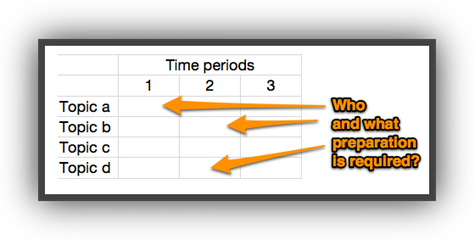
Technology Is Wiping Out Companies Faster than Ever
Victims of success
In our roles as consumers
we seek to further our interests
rather than that of a supplier.
We can switch when it suits our interests …
All our experience tells us that
the customer never buys
what the supplier sells.
Value to the customer
is always something fundamentally different
from what is value or quality to the supplier.
This applies as much to a business
as it applies to a university or to a hospital. — PFD
Marketing — inside - out OR outside - in
Every institution — and not only business — must build into its
day-to-day management four entrepreneurial activities that run in parallel.
These are conditions for survival today.
These entrepreneurial tasks differ from the more conventional management
roles of allocating present-day resources to present-day demands.
These entrepreneurial activities start with the outside
and are focused on the outside
And they repeat …
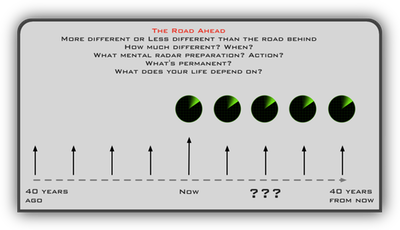
Regardless of the success of current endeavors,
an on going thought process is needed for making a different future
“Success always obsoletes the very behavior that achieved it.
It always creates new realities.
It always creates, above all,
its own and different problems.” — Peter Drucker
How do we keep our brain focused on the road ahead
and what’s next without it naturally slipping back
into the normal daily flow of events
that eventually lead to dead ends?

About 90 percent of the main page comes from Peter Drucker’s work
Although he passed away in 2005,
he’s still top of the food-chain. He had a completely
different approach from subject experts.

To get something our of this it is necessary to:
 Explore the page Explore the page
 Record areas a person might want to revisit — thought collector or thinking canvas Record areas a person might want to revisit — thought collector or thinking canvas
 Either to remember or work on Either to remember or work on
The things a person wants to remember are part of their “foundation for future directed decisions.”
Decisions that will have to be effective in the world on 2020 and 2030
 Decide what comes next Decide what comes next
 Then work it out in time Then work it out in time
What do these issues, these challenges mean for …
Larger ::: an alternative
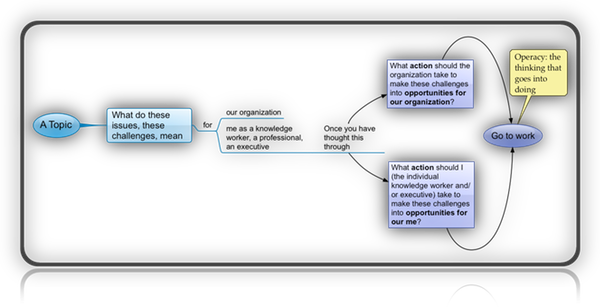
Dense reading and Dense listening and Thinking broad and Thinking detailed
Operacy — the thinking that goes into doing

Short tour links start below
 Change stories seen in the news Change stories seen in the news
 Urban world: The shifting global business landscape Urban world: The shifting global business landscape
 A thought collector for future focused radar blip noting, remembering and “needs doing” scanning A thought collector for future focused radar blip noting, remembering and “needs doing” scanning
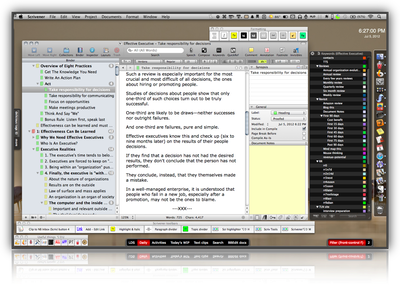
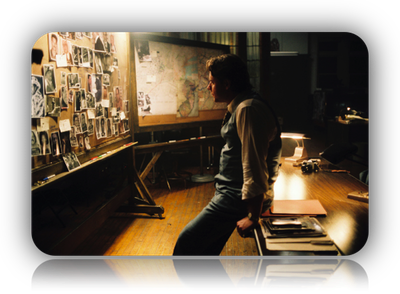
 WESR — What executives should remember (what’s the on-going action associated with each bullet point?) WESR — What executives should remember (what’s the on-going action associated with each bullet point?)
 Theory of the business (detailed outline) Theory of the business (detailed outline)
Bonus thoughts — not part of the original tour
 What’s behind Microsoft’s fall from dominance? What’s behind Microsoft’s fall from dominance?
Microsoft’s lost decade — a graphic
 Technology Is Wiping Out Companies Faster than Ever Technology Is Wiping Out Companies Faster than Ever
 Meaningful results (effective missions, change and continuity) Meaningful results (effective missions, change and continuity)
 Change and Continuity Change and Continuity
 Basic predictable trends Basic predictable trends
 The center of modern society is the managed institution — Drucker style The center of modern society is the managed institution — Drucker style
 Purpose and Objectives First Purpose and Objectives First
Not products or services (see marketing)
To Drucker, strategy, like everything else in management, is a thinking person’s game.
It isn’t arrived at by following some rigid set of rules but by thinking through various aspects of the business.
It all starts with objectives
“Only a clear definition of the mission makes possible clear and realistic business objectives.
It is the foundation for priorities, strategies, plans and work assignments.
It is the starting point for the design of managerial jobs, and, above all, for the design of managerial structures.
Structure follows strategy.
Strategy determines what the key activities are in a given business.
And strategy requires knowing what our business is and what it should be.
 More mission, objectives, strategy … More mission, objectives, strategy …
 “while the business was doing very well” “while the business was doing very well”
 What makes an Effective Executive (runs several levels deep) What makes an Effective Executive (runs several levels deep)
 They asked, “What needs to be done?” They asked, “What needs to be done?”
A foundation for future directed decisions is needed
 They asked, “What is right for the enterprise?” They asked, “What is right for the enterprise?”
 They developed action plans. They developed action plans.
 They took responsibility for decisions. They took responsibility for decisions.
 They took responsibility for communicating. They took responsibility for communicating.
 They were focused on opportunities rather than problems. They were focused on opportunities rather than problems.
 They ran productive meetings. They ran productive meetings.
 They thought and said “we” rather than “I …” They thought and said “we” rather than “I …”
 This one’s so important that I’ll elevate it to the level of a rule: Listen first, speak last This one’s so important that I’ll elevate it to the level of a rule: Listen first, speak last
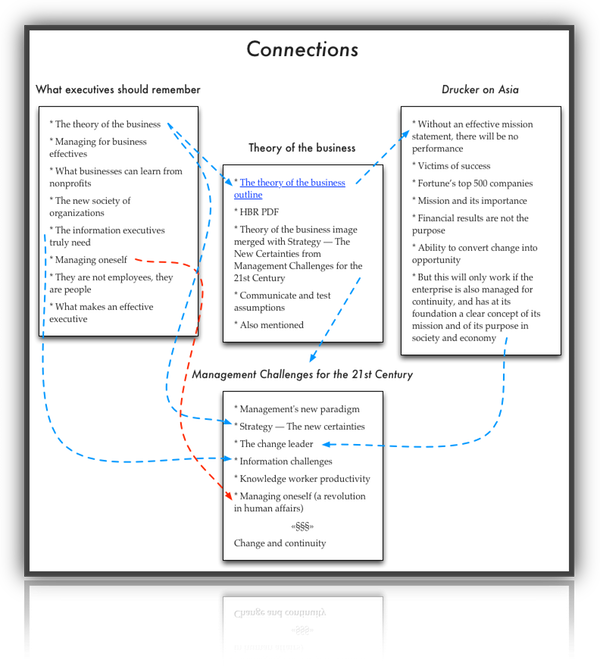
 Strategy—The New Certainties (an example from Management Challenges for the 21st Century) Strategy—The New Certainties (an example from Management Challenges for the 21st Century)
 Shifts in the Distribution of Income (bonus link) Shifts in the Distribution of Income (bonus link)

 Attention directing & flow (skipped to save time) Attention directing & flow (skipped to save time)
The essence of the multiple radar sweeps and working through time. Looking for new blips and trying to forget the past…
 Time books (skipped to save time) Time books (skipped to save time)
Blips from the evolving social and economic landscape (timescape)
 Just reading is not enough (from radar blip observation to daily action in a changing world) Just reading is not enough (from radar blip observation to daily action in a changing world)
Adiós Steve Ballmer
 Innovation in the existing organization requires special effort (an example of harvesting and action thinking) Innovation in the existing organization requires special effort (an example of harvesting and action thinking)
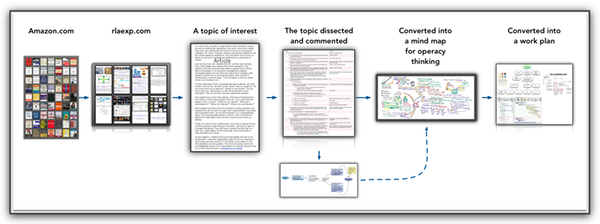
But the truly new venture tends to have a longer lead time.
Successful businesses, businesses that are today in the right markets with the right products or services, are likely ten years hence to get three-quarters of their revenues from products and services that exist today, or from their linear descendants.
In fact, if today’s products or services do not generate a continuing and large revenue stream, the enterprise will not be able to make the substantial investment in tomorrow that innovation requires.
It thus takes special effort for the existing business to become entrepreneurial and innovative.
The “normal” reaction is to allocate productive resources to the existing business, to the daily crisis, and to getting a little more out of what we already have.
The temptation in the existing business is always to feed yesterday and to starve tomorrow.
Organization efforts ::: Problems or Opportunities?
It is, of course, a deadly temptation.
... snip, snip ...
And it can be overcome in such a way that both the existing and the new, the mature and the infant, benefit and prosper. (Requires repeated action thinking as the world unfolds a little further down the road)
 Creativity (a.k.a. making the future happen) Creativity (a.k.a. making the future happen)
 Stifling (uninhibited and brainstorming — what everyone knows is frequently wrong) Stifling (uninhibited and brainstorming — what everyone knows is frequently wrong)
Imagine the ideas generated in a Sears, K-mart, Blackberry, Nokia, Microsoft or Radio Shack brainstorming session.
 Secret office a place to work on “what needs doing” Secret office a place to work on “what needs doing”
 Knowledge — THE resource Knowledge — THE resource

Thinking along a brainroad
The mental movie

Perils of the inside-out approach
 Definitive Drucker Definitive Drucker
The links on this page either drill down to more detail or a broader brainscape.
Part of this page is about doing an organization reset to the realities of the current situation and part about moving to the next major chapters in an organization's life story
Next chapters should prove bigger than previous chapters
 Luther, Machiavelli, and the Salmon Luther, Machiavelli, and the Salmon
Would you please read the first 2 sentences.
Beginning with “The railroad
How would you interpret this?
There are important action implications in the next few sentences
They need to go in somebody’s thought collector
Now if you’ll scroll down to
“In other words (it’s in big characters),
Now if would you scroll down again, until you see more large type.
“The next two or three decades are likely to see even greater”
«§§§»
The concepts and history within the paragraphs we just scrolled by are radar blips that provides a time scale within which The Definitive Drucker’s type thinking resides multiple times
Those multiple radar sweeps.
Also there is a connection to Drucker’s comments on innovation in the existing organization that we visited earlier
 Doing business in a Lego World (skipped, but important blip) Doing business in a Lego World (skipped, but important blip)
It provides the author's version of adaptive thinking, but not necessarily to the ideas in Luther, Machiavelli and the Salmon.
 Drucker on Asia — A Dialogue Between Peter Drucker and Isao Nakauchi Drucker on Asia — A Dialogue Between Peter Drucker and Isao Nakauchi
This is another major set of radar blips or some new brain addresses
Imagine someone working on the questions in The Definitive Drucker or other type thinking without having seen this mental landscape with includes the effective mission statement plus continuity and change ideas we visited earlier or Luther, Machiavelli, and the Salmon
Something would be missing from their conclusions
On top of this, these elements aren’t the complete landscape.
This landscape awareness could be viewed as a foundation for future directed decisions
In other words what do we need to consider in our decision thinking
Our next radar blip provides some examples
 The New Japanese Business Strategies The New Japanese Business Strategies
… demonstrate a potential level of thinking above the Definitive Drucker’s organization focus
 Manufacturing work does not belong in a developed country Manufacturing work does not belong in a developed country
 Leadership throughout the developed world rests on control of brainpower Leadership throughout the developed world rests on control of brainpower
 The winner in a competitive world economy is going to be the firm that most effectively shortens the product life of its own products The winner in a competitive world economy is going to be the firm that most effectively shortens the product life of its own products
 Zero-Defects Management Zero-Defects Management
 Budgeting as a long-term managerial tool (skipped) Budgeting as a long-term managerial tool (skipped)
This is more than a financial exercise.
Actually there are two budgets.
An operating budget and an opportunities budget each with different concepts
The opportunities budget is the road toward tomorrows.
With its multiple radar sweeps
The contents of a well developed thought collector should be helpful here.
Everything, we’ve seen, fits in somebody’s budget somewhere, and at sometime.
We’re all making decisions
about invisible time usage areas
whether we know it or not.
FROM Feeding Yesterday and Starving Tomorrow
TO Feeding Tomorrow and … Yesterday — PFD
We can only work on and with the things on our radar
How will the people in your organization
integrate what’s needed into their lives?
While there is adequate remaining time …
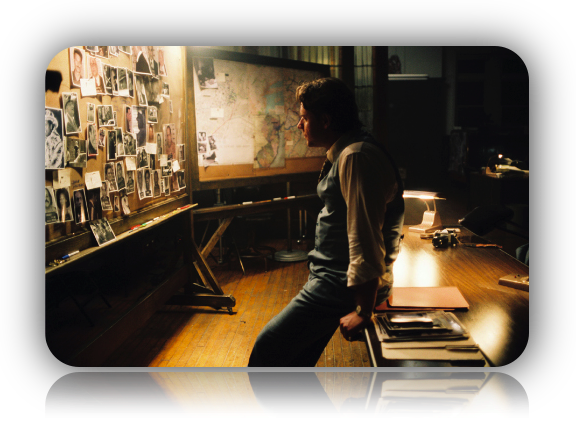
What if his cork board is viewed as radar screen?
The elements on the cork board could be considered radar blips.
His brain is doing a radar sweep
looking for patterns and connections
with a purpose.
What’s the next action?

Just about everybody enters the world of work through
known day-to-day operating work. How could we ever acquire a
strategic, dynamic worldview from our beginning vantage points?
Thought collector ::: Multiple radar sweeps ::: A systematic process is needed
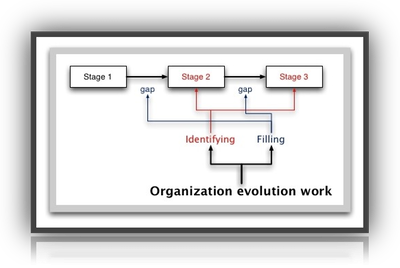
How does one keep oneself focused on
constantly pushing forward,
while not losing sight of the changing world around them?

«§§§»
The “thinking landscape and timescape” from What executives should remember … The Definitive Drucker … LMS … Drucker on Asia to … fits somewhere …
«§§§»
“Rather, they start out with business objectives and especially with market objectives.
They begin by asking “How much market standing (not the same as market share) do we need to have leadership?”
“What new products do we need for this?”
“How much do we need to spend to train and develop people, to build distribution, to provide the required service?”
Only then do they ask “And how much profit is necessary to accomplish these business objectives?”
Then the resulting profit requirement is usually a good deal higher than the profit goal of the Westerner.”
«§§§»
“What market standing does it need to maintain leadership?
What innovative performance does it need to support the needed market standing?
What rate of return is the minimum needed to earn the cost of capital?”
There are major time usage
and financial implications
How will the younger people who represent the future of America become motivated, familiar with and organized to work on the these types of conceptual radar blips?
To sum up the thinking along a brainroad section
All of the ideas we just visited are elements of working on working through time.
And even the most excellent decisions have a limited life span.
They get overtaken by events
Those multiple radar sweeps
Is there an antidote?
Is it in What executives should remember? Or the Windows of opportunity mentioned in The Definitive Drucker or further up the main page in Innovation and Entrepreneurship?
See notes at bottom of the page
And how will people work all of this into their lives?

 Economic stagnation and severe social tension from failure to raise knowledge and service worker productivity Economic stagnation and severe social tension from failure to raise knowledge and service worker productivity
 Getting back to now: the unexpected success, failure, or event Getting back to now: the unexpected success, failure, or event
To this point the action has been primarily aimed at getting beyond yesterday and working toward tomorrowS. This section deals with a Tsunami or something a little less dramatic.
Adiós Steve Ballmer
Notes and links to explore before initial fast read
Getting started?

Donations: Please click the button below to make a donation through PayPal.
Other forms of PayPal payment besides donations
rlaexp.com’s purpose is to provide a big picture thinking landscape for navigating our changing world — a world in profound transition.
There are 500+ pages inter-weaving management, leadership, organization evolution, the evolving content and structure of society, knowledge, technology, career evolution, education, learning, marketing, production, innovation, entrepreneurship, thinking, software tools, information challenges, concepts to daily action … through time. Any time someone is engaged in decision thinking they need a “foundation for future directed decisions.” ©
rlaexp.com is largely inspired by the work of Peter Drucker and a few others.
The site provides a “menu” for identifying important “things” to work toward that largely go unseen.
We can only work on, with and toward the “things” on our active “mental radar.”

In a changing world, we need a way to repeatedly look beyond current mental involvements.
We need a way to think about things we aren’t already thinking about at multiple points in time. Waiting for a crisis is one way to accomplish this, but surely there are better ways.
rlaexp.com’s uniquely broad landscape is designed to meet this challenge.
TomorrowS can’t be reached by today’s activities or thinking. Examples constantly flow through the news.
Who in 1950, 1970, 1990, 2000 … had an adequate future facing radar?
Why would today be any different?
Where and how we spend our time matters — a world in constant flux.
I’m trying to provide this exploration and thinking landscape to help people figure out what to do as we move deeper into the 21st century: a knowledge society, a society of organizations, and a network society.
America’s future depends on this awareness, ability and effective action.
It depends on younger generations having access to this dynamic type thinking and doing something effective. rlaexp.com provides the access and a work approach model.
Just about everybody enters the world of work through known, routine, day-to-day operating work at a point in time. It never seems to occur to nearly anybody that there could be anything else. How could we ever acquire a strategic, dynamic worldview from our beginning vantage points?
Pretending that tomorrow is going to be like yesterday is damaging.
Everybody has a vested interest in this.
For the site to remain available your support is needed. Your support helps with the books, software, web site hosting, and the time devoted to publicizing and enhancing the work approach available on rlaexp.com.
Who do you know that might be interested in working with me on spreading site usage and enhancement?
For the right kind of people, rlaexp.com provides the elements of a future facing consulting or mentoring practice. Contact info is near the bottom of most pages.

Notes
The content, the exploration, harvesting and action processes along with the thinking about thinking about it that we’ve just explored are aimed at providing a broad landscape and concrete work approach in multiple situations at multiple points in time.
This is a menu of time usage decisions with major financial implications.
These are decisions for creating the next chapterS in an organization’s or individual’s life story the way the iPhone was a new chapter in the Apple™ story — which continues to evolve.
By extrapolation, that makes it about the future of the developed world.
This future focus needs to be worked on when there is no obvious need.
There is a constant flow of organization crisis stories running through the news and they are almost all related to invisible time usage decisions.
We can only work on, with and toward the “things”
on our active “mental radar.”
A well stocked though collector and radar sweeps are needed.
If you buy Drucker’s reasoning on the dynamics of knowledge things are going to get more complex and thereby, more dangerous.
Repeatedly working though this page is a way to re-direct attention from current mental involvements at each radar sweep along the road ahead and generate new brainroadS.
Try tracing the brainroadS that constitute Apple’s™ history …
This site is a tool that can be shared with others. Somehow they need to be encouraged to do more than a page scroll. What pages did they visit? What did they harvest? How will they remember?
Working on this is a way to get beyond the day to day flow of events that eventually leads to a dead end. While a person is working on this they are doing something non-routine. Hopefully they are cautious about using their experience which relates mostly to different situations and the road behind. See using ignorance to your advantage and mindsets
Figuring out a way to introduce this process within an organization will require some choreography thinking and will have to evolve with needs and opportunities. Finding people willing to be attention directors or evangelists might be a start.
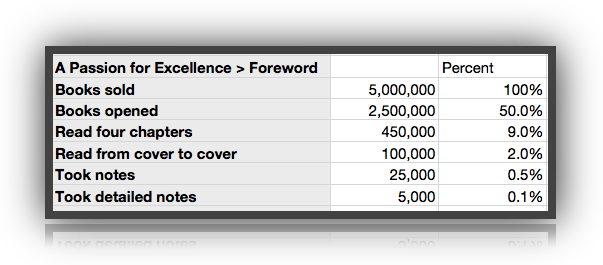
table above: Tom Peter’s observations on purchasers of In Search of Excellence.
Info was printed in A Passion for Excellence.
Just getting someone to work out a topic in time will help in their horizon building. This can substitute for expensive management or leadership courses.
REPRISE: Working through such a landscape is more than a one time process.
It brings one’s attention back to brain addresses that are basically invisible.
Such as the ideas in Luther, Machiavelli, and the Salmon or innovation in the existing organization
Second, third, fourth … visits will reveal new worldviews …
Drucker Quotations
“That knowledge has become THE resource, rather than a resource, is what makes our society “post-capitalist.”
This fact changes — fundamentally — the structure of society.
It creates new social and economic dynamics.
It creates new politics.
“The productivity of knowledge is going to be the determining factor in the competitive position of a company, an industry, an entire country”
“Knowledge is only knowledge in application”
“It is the very nature of knowledge that it changes fast and that today’s certainties will be tomorrow’s absurdities”
“Every organization has to prepare for the abandonment of everything it does”
“The modern organization must be organized for constant change”
“In a period of rapid structural change, the only ones who survive are the Change Leaders.”
“Success always obsoletes the very behavior that achieved it. It always creates new realities. It always creates, above all, its own and different problems.”
“The customer never buys what the supplier sells.
Value to the customer is always something fundamentally different from what is value or quality to the supplier.
This applies as much to a business as it applies to a university or to a hospital.”
“What everybody knows is frequently wrong”
“Those who keep doing what worked in the past are going to fail”
“Approach problems with ignorance—not experience”
A question:
At each radar sweep on the road ahead: how many billions of people on the planet are taking advantage of an organization’s specialized knowledge on a daily basis?
How can an organization expect to survive without the top power holder having a similar landscape awareness and action approach?
This page and its links aren’t nearly the entirety of the site
We can only work on, with and toward the “things”
on our active “mental radar.”
A well stocked though collector and radar sweeps are needed.
Difficulties of living in a changing world
 How does a person think about things they aren’t already thinking about? How does a person think about things they aren’t already thinking about?
 When we are embedded in doing something we are likely blind to the profoundly changing world around us. When we are embedded in doing something we are likely blind to the profoundly changing world around us.
 How do we keep our brain focused on the real road ahead and what’s next without it naturally slipping back into the normal daily flow of events that eventually lead to dead ends? Beware assumptions How do we keep our brain focused on the real road ahead and what’s next without it naturally slipping back into the normal daily flow of events that eventually lead to dead ends? Beware assumptions
 There’s no way to know what someone is going to be doing in ten or fifteen years. There’s no way to know what someone is going to be doing in ten or fifteen years.
 Just about everybody enters the world of work through known day-to-day operating work. Just about everybody enters the world of work through known day-to-day operating work.
 How could we ever acquire a strategic and dynamic worldview from our beginning vantage points? How could we ever acquire a strategic and dynamic worldview from our beginning vantage points?
 When the time comes to begin creating tomorrowS, what mental radar content will be available? When the time comes to begin creating tomorrowS, what mental radar content will be available?
 There is a need to work on this when there is no apparent need. There is a need to work on this when there is no apparent need.
 Otherwise, it sabotages one-self and one’s fellow employees, organization, community … Otherwise, it sabotages one-self and one’s fellow employees, organization, community …

Links to explore before initial fast read
 Thought collector Thought collector
 Annual review Annual review
 The customer never buys what you think you sell The customer never buys what you think you sell
 Perception more important than analysis: strategic ::: attention — preparing to see ::: sixteen different angles Perception more important than analysis: strategic ::: attention — preparing to see ::: sixteen different angles
 Secret office Secret office
Thinking …
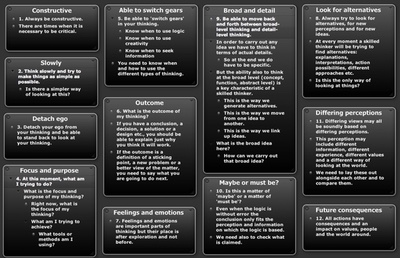
… at different points in time

 Attention directing and flow — preparing to see Attention directing and flow — preparing to see
 Creating competing patterns Creating competing patterns
 News (just a quick scan) News (just a quick scan)
 Urban world: The shifting global business landscape Urban world: The shifting global business landscape
 Why Drucker distrusted facts Why Drucker distrusted facts
 Argument vs. parallel thinking Argument vs. parallel thinking
 Information and thinking ::: Dense reading and dense listening Information and thinking ::: Dense reading and dense listening
 Thinking broad and thinking detailed Thinking broad and thinking detailed
 Using ignorance to your advantage Using ignorance to your advantage
 Challenge thinking ::: an alternative Challenge thinking ::: an alternative
 Operacy — the thinking that goes into doing Operacy — the thinking that goes into doing
 Only connect Only connect
Thought generator and a way to map ideas
An important tool for getting from concepts to daily action
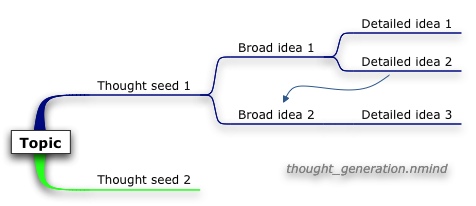
Questions ::: Thinking canvases
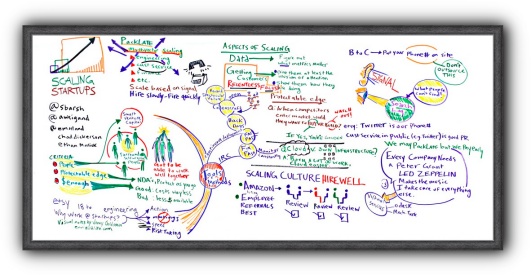
 Statistical abstract Statistical abstract
 Special librarians Special librarians

 Organization efforts ::: Problems or Opportunities? Organization efforts ::: Problems or Opportunities?
 How to guarantee non-performance How to guarantee non-performance
 Knowledge specialty Knowledge specialty
 New job, assignment … New job, assignment …
 Individual work lives Individual work lives
 What makes an executive effective What makes an executive effective
 Drucker on leadership Drucker on leadership
 Leadership Leadership

 The transformation The transformation
 Economic stagnation Economic stagnation
 Four entrepreneurial activities that run in parallel ::: True marketing Four entrepreneurial activities that run in parallel ::: True marketing
 Knowledge and technology Knowledge and technology



To create a rlaexp.com site search, go to Google’s site ↓
Type the following in their search box ↓
your search text site:rlaexp.com


Copyright 2001 2005 2007 2010 2011 2012 2013 2014 2015 2016 2017 © All rights reserved | bobembry | bob embry | “time life navigation” © | “life TIME investment system” © | “career evolution” © | “life design” © | “organization evolution” © | “brainroads toward tomorrows” © | “foundations for future directed decisions” © | #rlaexpdotcom © | rlaexpdomcom ©
rlaexp.com = real life adventures + exploration
#rlaexpdotcom introduction breadcrumb trail …
|


![]()